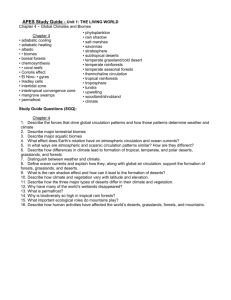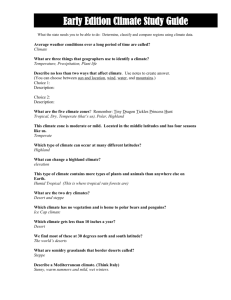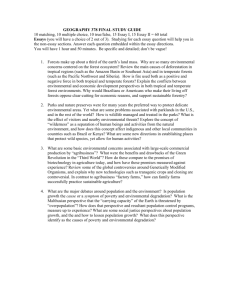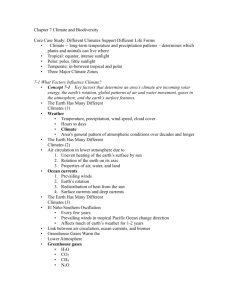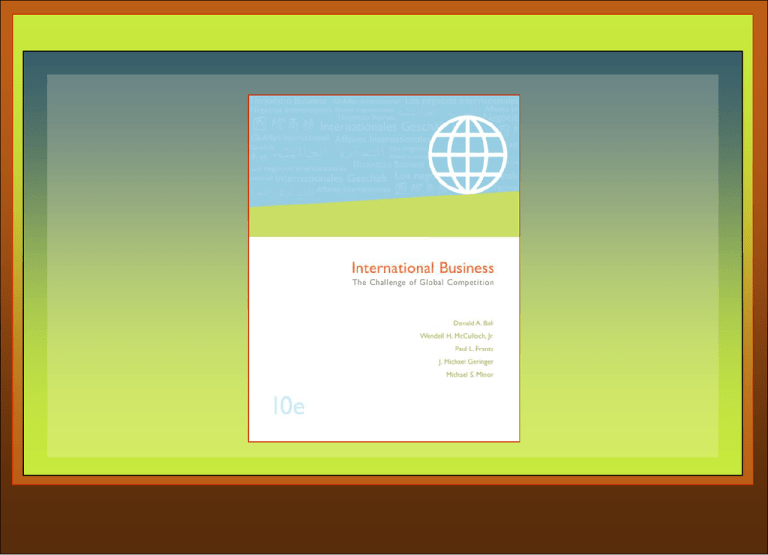
This chapter covers:
7
•Business relevance
of geography
•Importance of a
country’s location
Natural Resources and
Environmental Sustainability
•The contribution of a
country’s surface
features
•Importance of
waterways
•Discovery and use of
mineral resources and
energy sources
•Impact of industrial
disasters
International Business
by Ball, McCulloch, Frantz,
Geringer, and Minor
McGraw-Hill/Irwin
Copyright © 2006 The McGraw-Hill Companies, Inc. All rights reserved.
Chapter Objectives
Appreciate the relevance of four elements of geography
Understand the importance of a country’s location in political and
trade relationships
Understand the importance of a country’s location in political and
trade relationships
Comprehend the importance of inland waterways
Recognize that climate exerts a broad influence on business
Understand why managers must monitor changes in the discovery
and the use of energy sources and changes in a nation’s infrastructure
Appreciate the impact of industrial disasters
Describe major issues of the relationship between environmental
sustainability and international business
Develop a working definition of a environmentally sustainable
business
7-2
Why Switzerland Makes Watches
Mostly mountainous
Close to populated
lowlands of Western
Europe
Transportation across
mountains expensive
Has no mineral
resources
7-3
Natural Resources
Location
Topography
Climate
Sources of Energy
Non-fuel Minerals
Environmental
sustainability
7-4
Location
Political Relationships
Austria took advantage of its location to
Increase trade with the East.
Become the principal financial intermediary between
Western and Eastern Europe.
Strengthen its role as the regional headquarters for
7-5
international businesses operating in Eastern Europe.
Passive processing
Trade Relationships
Geographical proximity
Often the major reason for trade between nations.
Delivery faster, freight costs lower
The two largest trading partners of the United
States—Canada and Mexico—lie on its borders
Major factor in formation of trade groups such as
EU, NAFTA
Southern hemisphere opposite growing season
7-6
Topography
The surface features of
a region
Differences in
topography may
require products to be
altered
Cake mixes
Internal combustion
engines
7-7
Includes
Mountains and
Plains
Deserts and Tropical
Forests
Bodies of Water
Mountains and Plains
Insert Fig 7-2 Swiss
Map
Mountains Divide Markets
in
Spain
Switzerland
China
Colombia
Population Concentration
Mountains also create
concentrations of
population
7-8
Deserts and Tropical Forests
Deserts and Tropical
Forests
Separate markets
Increase the cost of
transportation
Create
concentrations of
population
7-9
Deserts and Tropical Forests
Deserts
Australia
Continent the size of the
7-10
U.S. but with only 19
million inhabitants.
Population concentrated
Along the coastal
areas in and around
the state capitals.
In the southeastern
fifth of the nation
Tropical Rain Forests
Brazilian Amazon
Occupies one-half of
Brazil
Four percent of
population
Canadian Shield
A massive area of
bedrock covering onehalf of Canada’s land
mass
Bodies of Water
Insert Rhine
photo
Attracts people and
facilitates transportation
Inland waterways
7-11
Provide inexpensive access
to markets
Rhine Waterway
Main transportation
artery of Europe
Carries a greater volume
of goods than do the
combined railways that
run parallel to it
Bodies of Water
Other Significant Waterways
The Amazon River in South America
The Parana and Paraguay Rivers in the Mercosur
region.
The Yangtze (China), the Ganges (India), and the
Indus (India) Rivers is Asia.
The Great Lakes--St. Lawrence and the
Mississippi River in the United States.
7-12
Outlets to the Sea
Permit low-cost
transportation of goods and
people
Africa has 14 of world’s
landlocked developing
countries
7-13
Must construct costly, long
truck routes
Port countries exert
considerable political
influence
Climate
Climate (temperature and precipitation)
Perhaps the most important element of physical
forces
Sets the limits on what people can do both
physically and economically
Climate has some influence on economic
development
Climate impacts product mix
Climate can impede distribution
7-14
Natural Resources
Anything supplied by
nature on which people
depend.
Principal types of
natural resources
important to
businesspeople
include
Energy
Non-fuel minerals
7-15
Energy
Non-renewable
Fossil fuels
Petroleum
Coal
Gas
7-16
Renewable
Hydroelectric
Wind
Solar
Geothermal
Waves
Tides
Biomass and ocean
thermal energy
Energy
Petroleum
Conventional sources - Oil
Estimates of oil consumption change because
New discoveries continue to be made in proven fields.
Governments open up their countries to exploration and
production.
New techniques enable producers to obtain greater output
from wells already in operation.
Automated, less expensive equipment lowers drilling costs.
7-17
Energy
World energy consumption
expected to increase by 54
percent from 2001 to 2025
Dramatic increases as
countries industrialize, such
as China
Oil expected to remain
dominant source, though
non-renewable
Will have to commit to
alternative energy source
when supplies run out
7-18
Insert figure 7-8 energy
consumption
Energy
Petroleum
Unconventional sources
Oil sands
Located primarily in Athabasca, Alberta, Canada.
Oil-bearing shale
Largest source is in Utah, Colorado, and Wyoming.
Coal
Used primarily in South Africa
Natural gas
Has been fastest growing source of energy
7-19
Energy
Sources of Renewable
Energy
Of the eight types,
7-20
hydroelectric has had an
extensive application.
Improved technology has
resulted in new support
for wind and solar energy
Wind energy fastestgrowing energy
technology in the world
Non-fuel Minerals
Nearly all of the world’s chrome, managanese,
platinum, and vanadium are produced by South
Africa and the former Soviet Union
The United States depends on South Africa
To supply 79 percent of its platinum, 78
percent of its chromium, 41 percent of it
manganese, and 20 percent of its vanadium
7-21
Changes Make Monitoring Necessary
Mineral Resources
One of the most
fascinating discoveries is
the fuel cell.
First used by NASA in
space capsules
Chemically converts
fuel directly to
electricity without
having to burn it
7-22
Natural Resources
Modifications of
infrastructure of great
significance to business
New highways and
railways reduce delivery
times
Chunnel connects
England and France
Oresund Bridge links
Denmark and Sweden
Destruction of Natural Resources
Historically nations have paid little attention to
contamination and destruction of natural resources
Tragedies have forced officials to recognize
Ixtoc 1 Well Blow Out
Chernobyl Nuclear Disaster
Alaskan Oil Spill
Eco-Terrorism in Gulf War
Aurul Mine Collapse
Events have led to “green approach”
7-23
Sustainable Business
An economic state where
demands placed on
environment can be met
without reducing capacity of
environment for future
generations
Three characteristics of
sustainable business
practices
Limits
Interdependence
Equity in distribution
7-24
Economic Challenges
Trade and market
liberalization
Eco-efficiency
Financial impact
Subsidies
New production
materials
Production and
consumption patterns
Stakeholder Based View
Insert Fig 7-16
China Oil Production and Consumption
7-27
U.S. Oil Imports
7-28
World Energy Consumption
7-29
European Wind Capacity
7-30

